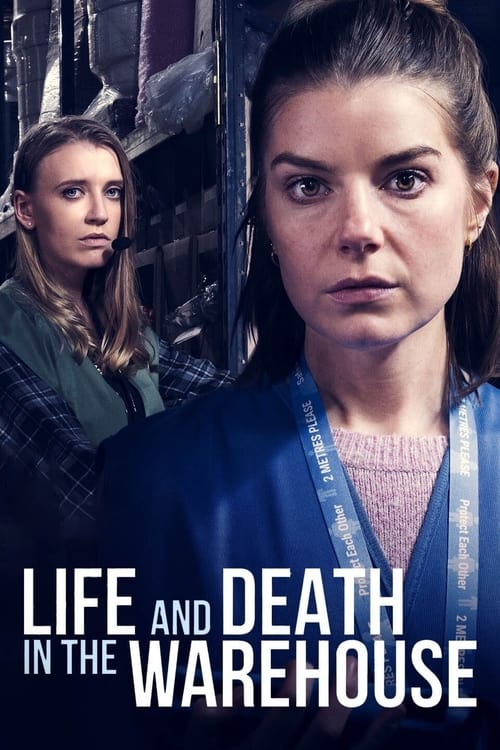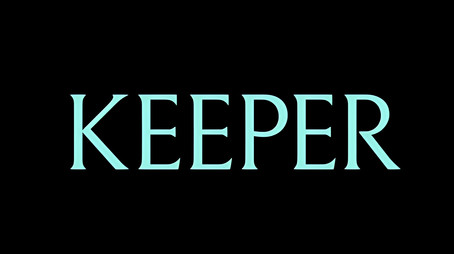
Ask Your Own Question
What is the plot?
The film Life and Death in the Warehouse opens within the cold, sprawling interior of a Welsh warehouse, its cavernous aisles lined with towering shelves stacked high with consumer goods. The air hums with the relentless buzz of fluorescent lights and the mechanical clatter of conveyor belts. Though no explicit date or time is given, the atmosphere is immediately oppressive, a world where every second is measured and every worker's movement scrutinized under the watchful eyes of CCTV cameras. The company's chilling mantra, "customer fixated," echoes throughout, a stark reminder that productivity trumps humanity here.
Into this unforgiving environment steps Megan Roberts, played by Aimee-Ffion Edwards, a fresh graduate on a fast-track managerial scheme. She is introduced as eager but naïve, quickly confronted with the brutal reality of the warehouse's corporate culture. Megan's role is to monitor the "pick rates" of workers--how many items each can select and pack per hour--and enforce strict targets without exception. Her first scenes show her seated before multiple screens, eyes darting between CCTV feeds and digital dashboards, tasked with policing her team's pace. The coldness of this surveillance system is palpable, a symbol of the dehumanizing machinery she is now a part of.
Among the workers is Alys Morgan, portrayed by Poppy-Lee Friar, Megan's childhood friend and a floor picker visibly struggling under the weight of her pregnancy. Alys is introduced with a quiet vulnerability; her movements are slower, her face pale, her breath sometimes shallow. Early on, she confides in Megan about her pregnancy and the high blood pressure complicating it, pleading for understanding. Yet the warehouse's relentless demands show no mercy. Alys's pick rate begins to falter, and Megan, caught between friendship and job security, starts to pressure her to meet the targets regardless of the risks.
The managerial hierarchy is embodied by Danny (Craig Parkinson), the senior manager, and Donna (Kimberly Nixon), his junior. Both are chillingly robotic, their empathy sacrificed at the altar of efficiency. They enforce policies with cold precision, viewing workers as mere cogs in the vast ecommerce machine. Their interactions with Megan are laced with veiled threats and corporate doublespeak, emphasizing the Orwellian nature of the workplace. Danny's voice is often clipped and dismissive, while Donna's reports on Megan's actions reveal the internal policing among managers.
The warehouse floor is the film's primary battleground--a vast, industrial space where workers like Alys and Megan's team scramble to fulfill orders under punishing time constraints. Surveillance cameras dot every corner, their lenses cold and unblinking. Break rooms and rest areas offer no respite--sparse, uncomfortable, and sterile, they underscore the lack of care for workers' wellbeing. Here, Devon, a union representative and Alys's friend, tries to advocate for the workers, but his efforts are largely ignored by management, highlighting the impotence of labor representation in this system.
As the story unfolds, the tension escalates sharply. Alys's health deteriorates visibly; her pick rate plummets as she battles exhaustion and the physical toll of pregnancy. Megan watches anxiously from the monitors, torn between sympathy and the pressure to maintain her own standing. A pivotal moment occurs when Megan catches Alys wiping blood on a tissue after a bathroom break. Instead of offering relief, Megan confronts her about idle time, accusing her of selfishness. Alys breaks down, insisting she is doing her best, revealing the emotional and physical strain she endures. "My family only has my paycheck coming in," Alys pleads, but Megan coldly insists she must keep working or risk losing her green vest--the symbol of employment.
During a break, Devon and another worker, Nadia, urge Alys to speak with Megan to get permission to go home. When Alys approaches Megan, she is met with a harsh ultimatum: leaving early would breach her contract and cost her maternity rights. Megan, now enforcing management's ruthless policies, refuses, forcing Alys back to the floor despite her worsening condition.
The situation spirals when Alys collapses in the bathroom, blood staining the floor. Nadia screams, and Devon urgently pleads with Megan to call an ambulance. Megan hesitates, haunted by the repercussions of her previous call for medical help, which had worsened team statistics and drawn managerial ire. Devon seizes her phone and dials emergency services, while they try to keep Alys calm and conscious. This incident starkly exposes the conflict between human compassion and the warehouse's brutal corporate priorities.
In the aftermath, Megan faces a severe reprimand from Danny and Donna. They berate her for "taking the easy way out," prioritizing medical intervention over productivity. The managers' cold indifference crystallizes the film's central theme: the devaluation of human life beneath the relentless drive for efficiency and profit. Megan's internal conflict deepens as she wrestles with her complicity in this system, her initial empathy eroding under the weight of corporate expectations.
Throughout the film, several revelations underscore the systemic exploitation at play. The euphemistic "Personal Enhancement Plan" emerges as a sinister tool used to push out underperforming workers like Alys under the guise of improvement. Despite medical advice that Alys avoid heavy lifting and strenuous activity, management refuses accommodations, exposing a callous disregard for worker health. Injuries and ailments are common but ignored, as symbolized by Craig's shoulder injury, which goes untreated in favor of maintaining pick rates.
Communication within the warehouse is dominated by surveillance and data, replacing human interaction with cold metrics. Management's language is deliberately manipulative, cloaking exploitation in corporate jargon. Workers communicate cautiously among themselves, with Devon's union efforts offering a faint, often futile resistance.
The climax arrives as Alys's health reaches a breaking point. After collapsing and being taken away by ambulance, her fate remains ambiguous but grim, a haunting symbol of the human cost exacted by corporate greed. Megan's transformation is complete; once an empathetic friend, she now embodies the ruthless managerial archetype she once despised. The film closes on her fully integrated into the system, enforcing the same dehumanizing policies that crushed Alys. The warehouse continues its relentless operation, a bleak testament to the ongoing cycle of exploitation.
No explicit on-screen deaths occur, but the implied life-threatening risks and the emotional toll on characters like Alys resonate powerfully. The film's final scenes emphasize the futility of individual resistance within a system designed to suppress humanity in favor of profit, leaving viewers with a stark, unsettling portrait of modern labor exploitation.
Thus, Life and Death in the Warehouse unfolds as a harrowing, unflinching narrative of friendship, betrayal, and survival within the cold machinery of corporate capitalism, revealing the devastating consequences for those caught in its gears.
What is the ending?
In the ending of "Life and Death in the Warehouse," the main characters confront the consequences of their actions throughout the film. Tensions reach a peak as they face a critical decision that will determine their fates. Ultimately, the warehouse becomes a symbol of their struggles, and they must choose between self-preservation and loyalty to one another. The film concludes with a poignant moment of realization and sacrifice, leaving the characters changed forever.
As the final act unfolds, the atmosphere in the warehouse is thick with tension. The dim lighting casts long shadows, emphasizing the weight of the choices that lie ahead. The main characters, Alex, Jamie, and Sam, gather in a secluded corner of the warehouse, their faces etched with worry and determination. They have just learned that the warehouse is set to be demolished, a decision that threatens their livelihoods and the fragile community they have built.
Scene by scene, the characters grapple with their emotions. Alex, the de facto leader, paces back and forth, his brow furrowed in thought. He feels the burden of responsibility for his friends and is torn between fighting for their jobs and the safety of their community. Jamie, the idealist, stands with her arms crossed, her eyes blazing with passion. She believes they should rally the workers and protest against the demolition, seeing it as a chance to unite and fight for their rights. Sam, the pragmatist, leans against a stack of crates, his expression conflicted. He worries about the repercussions of their actions and the potential for violence.
As they debate their options, the sound of machinery echoes in the background, a constant reminder of the impending change. The camera captures their faces, revealing the fear and determination that flickers in their eyes. The stakes are high, and each character's internal struggle is palpable. They know that whatever decision they make will have lasting consequences.
In a moment of clarity, Alex suggests they stage a sit-in to draw attention to their plight. Jamie's face lights up with enthusiasm, while Sam hesitates, concerned about the potential fallout. However, the urgency of the situation compels him to agree. They decide to gather their fellow workers, and the scene shifts to a montage of them rallying support, their voices rising in unison as they chant for their rights.
As the sit-in begins, the warehouse is filled with a mix of hope and anxiety. The camera pans over the crowd, capturing the diverse faces of the workers, each with their own story and reason for fighting. The atmosphere is electric, but tension simmers beneath the surface as security personnel arrive, ready to remove them.
In the climax of the film, a confrontation ensues. The workers stand their ground, but the security team is relentless. Alex, feeling the weight of the moment, steps forward to speak on behalf of the group. His voice trembles with emotion as he pleads for understanding and compassion. The scene is charged with raw emotion, and the camera zooms in on his face, capturing the desperation and hope intertwined in his expression.
Just as it seems the situation will escalate into chaos, Jamie steps forward, urging everyone to remain calm. She emphasizes the importance of unity and non-violence, and her words resonate with the crowd. The tension begins to dissipate, and for a brief moment, it feels as though they might achieve their goal.
However, the resolution is bittersweet. As the workers begin to disperse peacefully, the warehouse's fate is sealed. The demolition crew moves in, and the characters watch helplessly as their home is dismantled. Alex, Jamie, and Sam stand together, their expressions a mix of sorrow and resilience. They realize that while they may have lost the warehouse, they have gained a deeper understanding of their strength and solidarity.
In the final moments, the camera lingers on each character. Alex, though heartbroken, vows to continue fighting for workers' rights. Jamie, inspired by the experience, decides to pursue activism full-time. Sam, having faced his fears, finds a renewed sense of purpose in advocating for his community. The film closes with a shot of the three of them walking away from the rubble, united in their resolve to create change, their silhouettes framed against the setting sun, symbolizing both an ending and a new beginning.
Is there a post-credit scene?
In "Life and Death in the Warehouse," there is indeed a post-credit scene that adds a layer of depth to the film's themes.
As the credits roll, the screen fades to black before transitioning to a dimly lit corner of the warehouse. The camera slowly pans across the cluttered space, revealing remnants of the chaos that unfolded throughout the film. Shadows dance across the walls, creating an eerie atmosphere.
Suddenly, a figure emerges from the shadows--it's one of the supporting characters, Alex, who had a minor role but was deeply affected by the events. Alex is seen meticulously cleaning up the area, picking up discarded items and organizing them. The emotional weight of the warehouse's past hangs heavily in the air, and Alex's expression is a mix of determination and sorrow.
As Alex works, they find a small, forgotten item--a photograph of the main characters, taken during a brief moment of camaraderie before the turmoil began. The sight of the photograph triggers a flood of memories, and Alex pauses, staring at it with a bittersweet smile. This moment encapsulates the film's exploration of loss, resilience, and the lingering impact of shared experiences.
The scene concludes with Alex placing the photograph on a shelf, a silent tribute to those who were lost and a symbol of hope for the future. The camera lingers on the photograph for a moment before fading to black, leaving the audience with a sense of reflection on the fragility of life and the importance of remembering those who have shaped our journeys.
What motivates the main character, Alex, to take risks in the warehouse?
Alex, a young warehouse worker, is driven by a desperate need to provide for his family after his father's unexpected death. His internal struggle between the desire for stability and the lure of quick money leads him to take dangerous risks, including engaging in illegal activities within the warehouse.
How does the relationship between Alex and his co-worker, Mia, evolve throughout the film?
Initially, Alex and Mia share a professional camaraderie, but as they face the harsh realities of their work environment, their bond deepens. Mia becomes a source of emotional support for Alex, and their relationship shifts from friendship to a romantic connection, complicating their decisions and actions in the warehouse.
What role does the warehouse manager, Mr. Thompson, play in the story?
Mr. Thompson is portrayed as a strict and often ruthless figure, embodying the oppressive corporate culture of the warehouse. His actions and decisions create a tense atmosphere, pushing employees like Alex to their limits. His character serves as an antagonist, representing the challenges and moral dilemmas faced by the workers.
What specific events lead to the climax of the film?
The climax is triggered by a series of escalating incidents, including a dangerous accident caused by negligence and the discovery of illegal activities within the warehouse. Tensions rise as Alex must choose between loyalty to his friends and doing the right thing, culminating in a dramatic confrontation with Mr. Thompson.
How does the film depict the theme of survival among the warehouse workers?
The film illustrates survival through the daily struggles of the workers, showcasing their camaraderie and resilience. Specific scenes highlight their efforts to navigate hazardous conditions, cope with low wages, and support each other in the face of adversity, emphasizing the lengths they will go to protect one another and secure their livelihoods.
Is this family friendly?
"Life and Death in the Warehouse," produced in 2022, is not considered family-friendly due to its mature themes and intense emotional content. The film explores complex issues surrounding life, death, and the human condition, which may be distressing for children or sensitive viewers.
Potentially objectionable or upsetting aspects include:
-
Death and Grief: The film deals with themes of mortality, featuring scenes that depict characters grappling with loss and the emotional turmoil that follows.
-
Intense Emotional Conflict: Characters experience significant internal struggles, leading to moments of despair, anger, and frustration that may be difficult for younger audiences to process.
-
Workplace Tension: The setting in a warehouse environment may include scenes of high stress, conflict among workers, and the pressure of deadlines, which could be unsettling.
-
Realistic Portrayals of Struggle: The film presents raw and realistic portrayals of life's challenges, including poverty and existential crises, which may be heavy for younger viewers.
-
Mature Language: There may be instances of strong language used by characters, reflecting their emotional states and the intensity of their situations.
These elements contribute to a narrative that is more suitable for mature audiences, as they require a level of emotional understanding and resilience that younger viewers may not possess.



















